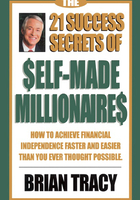Discovering Dreams
Established WANTS anchor the top corner of the GTD model. The clearer the WANTS, the more specific you can be about the gap between the WANTS and REALITY. And, clear WANTS tell us about the motivation and energy available to us in the key PEOPLE. The previous chapter helped you imagine what you want and value, a good step before attempting to move your organization. Next, begin involving others in the same process; you need to know what they want—especially what they want that you also want. Your focus, and the primary focus of this chapter, is helping others discover what they want.
Wants Always Exist
Here is a sampling of wants collected from group meetings in an Internet company. When asked what they want, people said:
Stock options To get along better with the boss
A more motivated work team Lifelong happiness
To reduce the scrap rate To make a plan this month
A sabbatical To be proud of their work
To leave this meeting early To cut back to a 70-hour week
More flexible work hours To raise healthy children
A computer at home To celebrate work successes
A cold beer An online training program
To clean up their paperwork
I offer this diverse array of wants so you will think about what is going on in the minds and hearts of the people with whom you work. A similarly diverse array faces you when you begin your work of aligning what your key people want. They are wondering and weighing what you might be offering against what they want. “How will this help me get what I want?” is the question on their minds. Their wants, and their self-serving question, deserve your respect.
If you have never asked people what they want, your initial reaction to their responses might be to resolve never to do it again. People have so many different wants that to hear them can be overwhelming. Whether you ask or not, the wants are there, waiting to be expressed. When you don't ask, you condemn yourself to ignorance and guessing. When you do ask, people express what is important to them in their work and lives; this is information you can use. When you do not ask, you will not know.
When you ask, people usually appreciate it. They usually don't say “Wow, thanks, you are terrific!” They show their appreciation through the enthusiasm they bring to their responses. Even an angry person who rants on is saying, at one level, “I value this opportunity to say what is on my mind. That's why I am talking like this, letting off steam. It's nice to know that someone cares what I think and feel.” And you, of course, reinforce this thought by telling people, showing them, that you appreciate hearing from them. You tell them what you've heard; you check to make sure that you understand. You restate what they have said in your own words. All of this helps them know that they are getting through to you.
What happens when people express wants that cannot be met? Whether their wants can be met or not, people still have them. Whether you ask them or not, they are going to compare your wants to their wants and decide how much they will cooperate. Understanding their wants is valuable information for you, helping you to assess the possibility of bringing about change.
Express the Dream
Do it yourself and help others do it. Reaching for a better day or better work or a better life requires that people talk about it. And they must express much more than what they know about the REALITY that faces them today; they must talk about the new reality they want. This is a little risky for people because maybe this new reality will never come about. True, but if they never talk about it, they will not know what they want to do together. Dreams, hopes, fantasies, and visions draw us forward—whether we want to acknowledge them or not. Your challenge is to find ways to get people to dream together. Not about what they want next week, but what they want next year and beyond.
Nowadays many organizations have prepared written vision, values, or mission statements. This is not a bad place to start. Though often these statements are not widely endorsed by workers, they legitimize the function of organizational dreaming. The written statement can be a good backboard off of which a group can bounce their ideas. If your organization has not developed a vision statement, start by asking questions related to the future people want and why that is important to them. You are not looking for sophisticated responses, but honest responses. When you hear people speak about what they want, their responses suggest where their energy lies and how you might draw on that energy.
Discover What They Want That You Want
Start with the assumption that there is something that they want that you also want; it is just a matter of discovering what your common wants are and how immediate they are to the present situation. The closer the wants are to what faces all of you today, the better. For example, if you need a little help budgeting right now, and I have the skills, time, and desire to help, our immediate wants overlap. We will come to quick agreement and go to work. On the other hand, if you are behind schedule in production, and I need your budget yesterday, our common wants are not as evident and overlapping in the immediate situation facing us. This makes our work together more difficult.
Successful working relationships depend on discovering now what you and others want together. For example, when you and I resolve a pressing issue together now, an issue we both care about now, that breeds success. Or, in the example above—when I provided you with a little budgeting help—that also fits the bill: It is mutual and immediate; we are both invested. At the other end of the spectrum are the most difficult problems—the ones where you can find nothing that you both want from the present situation, and neither can you find anything in the organization that you both want. Then you have to appeal to mutual life values like success, growth, happiness, and strength to join the people involved. It is quite a reach to bring two people together with only these personal wants and values in common, but it is still a starting point. Consider:
What do I want?
What do they want?
What do our wants have in common?
Which of these wants might be met immediately through working together?
How can I help us realize our common wants?
Build Commitment to Wants
One “secret” to getting things done is helping people to discover what they really want. All of us can get so caught up in doing our work that we lose track of what we really want. Help others think about what they really want to accomplish through their work. A second “secret” is to enlist people's commitment to what they want. Discovering and becoming clear about what you want does not automatically move you to action. For example: I want to lose weight and I am doing absolutely nothing about it. Lately, I've just been so busy—I do want to lose weight, but not just now. If I committed to being healthier and thinner, that would be significantly different. Commitment moves me past a more neutral understanding of what I want to doing something about it. Commitment is taking responsibility for building what we want.
Reinvent the Wheel
“Let's not reinvent the wheel.” How many times have you heard that? I am here to argue that we must reinvent the wheel. Despite the caution, we reinvent wheels regularly and successfully. I am not arguing that it's necessary every time, but most of what we do involves reinventing something that has been done before. Most of what we do in our lives has been done before by somebody else. Our parents were very good at reminding us of this, and we are almost as good at reminding our own children. This is equally true in organizations. Those who do not learn from history (past wheels) are doomed to repeat it. We repeat history because, although it has been done before, we did not do it. And we want to, need to, do it ourselves in order to believe it, to commit to it, to take pride in it. We want to do it ourselves so that we will know what it is like at a personal level.
Why did we reinvent a capital assets system that is available from our accountant? Why did we build an orientation program for our area instead of using the one that headquarters provides? Why did we design our own website when we could have borrowed the design of a neighboring region with much less effort? Why? Because we want to do it ourselves, we want to own it, we want to be committed to it, we want to believe in it, we want to be proud of it, we want to say “We did this! This is our wheel!” Besides, we really don't understand how and why it works until we have done it ourselves.
Now let's shift our focus to your work. Imagine that you are about to propose a new program (or system or procedure or structure) for your organization that would replace an existing one. Imagine that what you are proposing has been very successful in many organizations similar to yours. People here will love it—once it is in place. But do they believe this? Do they trust your recommendations? Do they accept the successful experiences of others? No, no, and no. So, what do you do? If you are smart, you reinvent the wheel. You know that the new program is not all you are working with here. You know that you need the support of real people, with real energy that they can use for or against it. So you spend hours helping people look at their wants and needs. You involve all the key people who could be involved with the new program. You attend to their needs for special tailoring to their unique situation. And this isn't whitewash; you really do pay attention. You look forward to the day when they say “This is our system; we built it the way we wanted it.” The program needs commitment over the long term and you get that by engaging the group in reinventing the wheel.
Help Them Know That You Know
We often act like we “know” what is going on. We tell others that we know; we want them to know that we understand. And, often we are wrong. I am trying to learn from experiences like this one: I was telling a group of directors about the problems they had working with the divisions of the organization. I said that I knew how this bothered them and knew what they could do about it. Fortunately, early inquiries from the group revealed that they did not want to hear my opinions on what they wanted and needed. They preferred to tell me about the difficulties they were having adjusting to a recent merger with another organization. That was the pain they wanted to deal with right then. My opinions about problems with their divisions were not relevant at this moment. I could have tried to convince them that we should talk about my agenda and that would have failed. We did what they wanted to do, and that worked.
It is not enough for you to know what they want: They must know that you know. When they do, they are ready to move forward. When others think you do not understand what they want, they will move only with great reluctance. The frustration caused by a problem—or the enthusiasm generated by an opportunity—releases energy and allows people to lean into action. When you propose action steps before these feelings are expressed, you are likely to get resistance. People will not be ready to move into solutions until they have expressed their feelings about the situation as it exists now and how it differs from what they want. It is common for groups to have a general, loose agreement about what they want but to disagree strongly about what should be done to move toward this common want. The agreement is the part to focus on. You can only help your group move forward in areas where they agree. Unresolved disagreements within the group pull them and dissipate the energy needed to move to action.
Collaboration and Negotiation: Your Best Options
Working with people often comes down to one of three situations: (1) You have the same wants, (2) you have different wants, or (3) both are true. Same wants call for collaboration: “When we work together, we will get what we both want.” Different wants call for negotiation: “I'll help you get what you want; you help me get what I want.” A mix of different or overlapping wants calls for a combined tactic: “Let's work toward this goal together because we both want it, and then we can support each other on what we each want that is different.”
Each position calls for you to be clear about what you want from the people with whom you are working. You expect the same clarity from them. Expect toe-to-toe encounters. Expect some searching for higher ground. Expect candor. Expect to work hard to get what you want and they want. It's not easy to be truly collaborative or to negotiate openly.
Competition and Avoidance: Not Your Best Options
In your search for shared wants, you don't have to collaborate or negotiate; you can compete or avoid. But these latter two tactics do not regularly work well for people who are not in charge. Perhaps for someone else, but not for you. Consider the competitive approach: “We both want the same thing; only one of us can have it.” We are all familiar with this option, but how well does it work for you? Competing and winning over others is not the way to gain their support. Consider, are you prepared to compete? What do you have in your arsenal? How well does your position in the organization prepare you to compete? What if they win? Consider the consequences for you, the others, and the organization; you will likely move on to other tactics.
A fourth tactic is to avoid the people and the issue altogether. This gains you temporary protection, but seldom progress. Important differences in wants between others and yourself must be faced for the sake of your own effectiveness. The issue will have to be dealt with; you cannot count on its going away. Yes, avoiding can be a legitimate tactic— you just need to consider the consequences. Usually avoidance does not contribute to your power in the organization.















